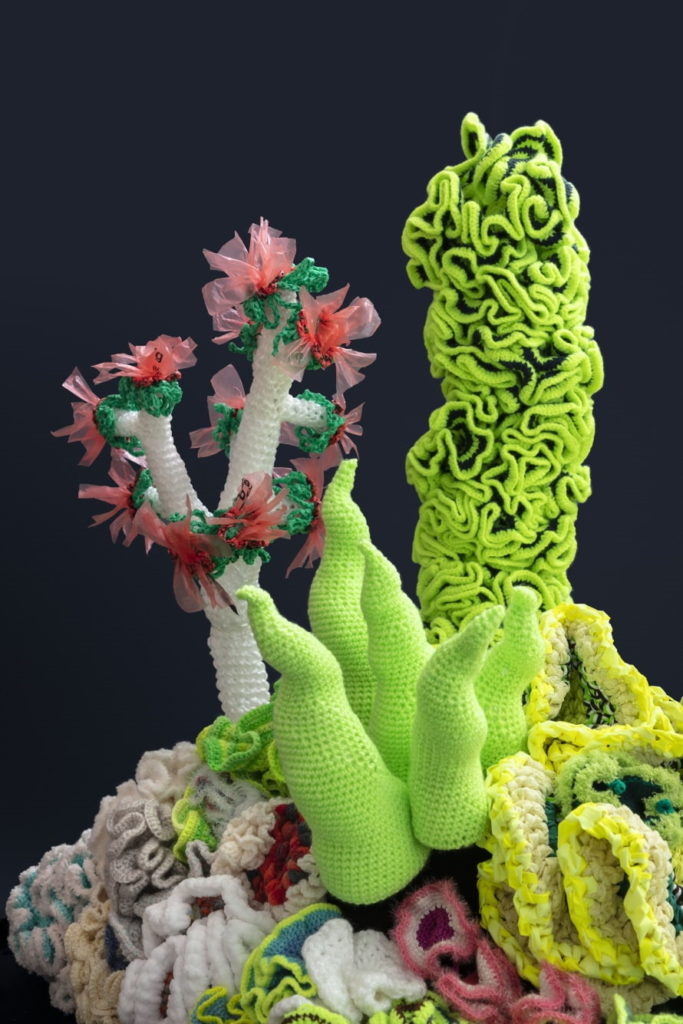Coral reefs around the world are being destroyed by global warming. In response to this environmental tragedy, artist sisters Margaret and Christine Wertheim have created a body of work based on the resources of traditional needlework techniques. Their crocheted coral reefs represent a spatial simulation of colours and shapes inspired by Australia’s Great Barrier Reef: a collective act of artistic production that has involved thousands of people around the globe, an aesthetic symbiosis of art, science, mathematics and collective practice that is based on the infinite possibilities of creative handwork.
The project was first presented to the international art public at the Venice Biennale 2019. Now the Museum Frieder Burda in Baden-Baden is presenting a comprehensive homage to the work of the two artists in the form of an installation that virtually “sprawls” into the entire house. Udo Kittelmann, artistic director of the museum, developed the exhibition in close collaboration with the Wertheim sisters.
Image above: Christine and Margaret Wertheim, Baden-Baden Satellite Reef, Museum Frieder Burda, Baden-Baden
The world’s coral reefs are under threat The Great Barrier Reef, the first living thing visible from space due to its immense size, covers 344,000 square kilometres. But in recent decades, 60% of this maritime wonder has succumbed to coral bleaching, with vast areas of once vibrant life now dead. Traditional pressures from overfishing, tourism and agricultural runoff are now compounded by ocean warming and ocean acidification, both consequences of the economic supremacy of the global petrochemical industry. The Crochet Coral Reef project raises awareness and encourages reflection on this major anthropogenic crisis. It represents an artistic installation that is both emotional and monumental in that it impressively brings together the two levels – the handicrafts executed privately and then exhibited publicly: The subjective activity is transformed into the collective staging in the public space of a museum.

Margaret and Christine Wertheim
The unusual encounter of art and science in the Crochet Coral Reef project reflects the professional and personal lives of the Wertheim sisters. Margaret not only works as an artist, but is also an internationally renowned science writer and author of books on the cultural history of physics. Christine, a poet and former painter, has taught Critical Studies and Art Theory at Goldsmith’s College in London and the California Institute of the Arts in Los Angeles for decades. Since the two sisters learned to make their own clothes as children, the combination of arts and crafts with conceptual approaches from science and art is obvious to them. At the same time, they are pursuing a feminist approach. Their project is consciously in the tradition of Judy Chicago’s well-known artwork “The Dinner Party” and Mierle Ukeles` pioneering work in the field of “social practice”.
Since they began their joint projects in 2005, the Wertheim sisters have worked with communities in 50 cities and various countries to create the “crochet reefs” that are significant for their work on site. To date, almost 20,000 people, mostly women, have contributed to this installation-based body of work. In Baden-Baden, the project has generated an unprecedented response. More than 40,000 crocheted corals have arrived at the museum in response to the previous public appeal. Throughout Germany, communities have joined together in the spirit of “creative crocheting” to draw attention to the crisis in the world’s oceans in this way.

Integration of arts and crafts with female connotations and applied mathematics
It is no coincidence that specific forms of handicrafts normally associated with female identity are the subject of numerous current exhibitions and reassessments. In them, subtle messages about self-determination, quiet rebellion and feminist protest are articulated; coded texts are inscribed and woven into the objects and practices made with readily available textile materials.
At the same time, the project also encompasses a mathematical dimension. For the forms made here are based on hyperbolic geometry, an alternative mathematical theory beyond classical Euclidean geometry. All the curled, coral-like shapes on display in this exhibition are handcrafted simulations of mathematical forms as formed by corals and other marine organisms. By crocheting with yarn, the authors of the works engage in a kind of applied mathematics; at the same time, they relate craft and geometry to climate change and the evolution of life on earth. “Just as living things evolve through small changes in an underlying DNA code, the crocheted coral reef evolves through small changes in an underlying crochet code. This creates a taxonomy of crochet coral ‘organisms’,” the two sisters say of their work.

WHEN?
Saturday, January 29th – Sunday, June 26th, 2022
Opening hours: Tue-Sun, 10 am – 6 pm
open on all public holidays
WHERE?
Museum Frieder Burda
Lichtentaler Allee 8b
76530 Baden-Baden
www.museum-frieder-burda.de






